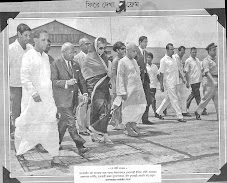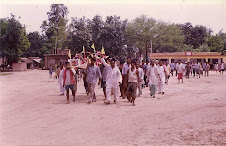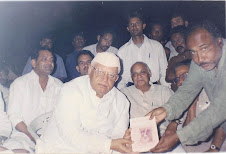Economic policy: Shooting in the dark
What was India's gross domestic product (GDP) growth rate during the first quarter of the year? Is industrial production rising or falling? What about services? What is the inflation rate? Is it rising or falling? The list can go on and on. For, the truth, unpalatable as it might be, is we really don't know.
As a result, economic policy formulation has become more like a game of shooting in the dark. Policy authorities don't know which way to turn in a scenario where the three pillars of a sound statistical database - credibility, timeliness and adequacy - are absent.
Forget the arcane debate about whether the Reserve Bank of India (RBI) should use the wholesale price index ( WPI) or the consumer price index ( CPI) - and if it is the latter, which of the three CPIs, urban, rural or national - while taking a view on monetary policy. That is a trifling matter of detail compared with the far more important issue of whether the index used gives us an accurate measure of inflation. This is not a matter of academic interest; rather, it has huge implications for policy.
Take, for instance, the RBI's forthcoming (on October 25, 2011) second-quarter review of monetary policy. As the central bank wrestles with the dilemma of whether to continue, pause or stop in its tracks, it needs to know, and with far more certainty than at present, how far its policies have slowed down the level of economic activity, how far they have impacted inflation and so on. In short, it must be able to get its finger on the pulse of the economy and also ameasure of the pulse rate.
Unfortunately, it is not able to do so at present, thanks to the flaky data that it is, perforce, compelled to rely on. Inevitably this impacts both the quality of the decision-making as well as the outcome.
Garbage in, garbage out! The RBI, in fact, has paid a heavy price for its reliance on dodgy data. As RBIgovernor D Subbarao pointed out in a recent speech, "Policy is framed real time and if the provisional data that these are based on are inaccurate, the resultant policies can turn out to be suboptimal choices.
"Take, for instance, estimates of GDP growth. The advance estimate of GDP growth in 2009-10 growth at market prices in February 2010 was 6.8%. That was changed to 7.7% in the revised estimate in May 2010 and further to 9.1% in the quick estimate in February 2011. Therefore, policy that perforce had to use information on the advance estimate of GDP was fraught with the risk of underestimating the growth momentum."
Likewise, during December 2008-June 2009, when the global financial crisis was at its peak, the index of industrial production (IIP) showed positive industrial growth even though one would have expected a deceleration; a fact that was subsequently borne out by the new IIP series (with 2004-05 as the base). Any policy based on the first set of data would, therefore, have been way off the mark. It is not only GDP or IIP data that suffer from infirmities. Data on wholesale price index (WPI) inflation too has been subject to large revisions, usually upward.
Ironically, data compilation was relatively easier in the licence-permit raj where the state oversaw almost every aspect of economic activity. But the demise of the earlier system and dependence on voluntary compliance has meant steady erosion in data quality. The problem is particularly acute when it comes to data on agriculture and the services sector.
In the former, old systems such as the village patwari (revenue collection officer) that were used to collect estimates of crop areas under cultivation have fallen into disuse and have not been replaced by new systems. As for the services sector, all we have is a five-year survey from which data is extrapolated to get annual data.
Unfortunately, despite the setting up of the National Statistical Commission, nothing much has changed at the grassroots level. We need a drastic change in mindset with both central government ministries and state governments according much more importance to the collection of statistics.
The collection machinery needs to be beefed up in tandem; today, there is a huge dearth of field-level staff that can be entrusted to collect data. Back in the middle of the last century, Sir Josiah Stamp, the well-known economist and statistician, pointed out, "The government [is] extremely fond of amassing great quantities of statistics.
These are raised to the nth degree, the cube roots are extracted, and the results are arranged into elaborate and impressive displays. What must be kept ever in mind, however, is that in every case, the figures are first put down by a village watchman, and he puts down anything he damn well pleases."
As the world prepares to celebrate the second World Statistics Day later this week (20 October) and the RBI its policy stance, it is only appropriate to highlight the importance of reliable and timely statistics.
As a result, economic policy formulation has become more like a game of shooting in the dark. Policy authorities don't know which way to turn in a scenario where the three pillars of a sound statistical database - credibility, timeliness and adequacy - are absent.
Forget the arcane debate about whether the Reserve Bank of India (RBI) should use the wholesale price index ( WPI) or the consumer price index ( CPI) - and if it is the latter, which of the three CPIs, urban, rural or national - while taking a view on monetary policy. That is a trifling matter of detail compared with the far more important issue of whether the index used gives us an accurate measure of inflation. This is not a matter of academic interest; rather, it has huge implications for policy.
Take, for instance, the RBI's forthcoming (on October 25, 2011) second-quarter review of monetary policy. As the central bank wrestles with the dilemma of whether to continue, pause or stop in its tracks, it needs to know, and with far more certainty than at present, how far its policies have slowed down the level of economic activity, how far they have impacted inflation and so on. In short, it must be able to get its finger on the pulse of the economy and also ameasure of the pulse rate.
Unfortunately, it is not able to do so at present, thanks to the flaky data that it is, perforce, compelled to rely on. Inevitably this impacts both the quality of the decision-making as well as the outcome.
Garbage in, garbage out! The RBI, in fact, has paid a heavy price for its reliance on dodgy data. As RBIgovernor D Subbarao pointed out in a recent speech, "Policy is framed real time and if the provisional data that these are based on are inaccurate, the resultant policies can turn out to be suboptimal choices.
"Take, for instance, estimates of GDP growth. The advance estimate of GDP growth in 2009-10 growth at market prices in February 2010 was 6.8%. That was changed to 7.7% in the revised estimate in May 2010 and further to 9.1% in the quick estimate in February 2011. Therefore, policy that perforce had to use information on the advance estimate of GDP was fraught with the risk of underestimating the growth momentum."
Likewise, during December 2008-June 2009, when the global financial crisis was at its peak, the index of industrial production (IIP) showed positive industrial growth even though one would have expected a deceleration; a fact that was subsequently borne out by the new IIP series (with 2004-05 as the base). Any policy based on the first set of data would, therefore, have been way off the mark. It is not only GDP or IIP data that suffer from infirmities. Data on wholesale price index (WPI) inflation too has been subject to large revisions, usually upward.
Ironically, data compilation was relatively easier in the licence-permit raj where the state oversaw almost every aspect of economic activity. But the demise of the earlier system and dependence on voluntary compliance has meant steady erosion in data quality. The problem is particularly acute when it comes to data on agriculture and the services sector.
In the former, old systems such as the village patwari (revenue collection officer) that were used to collect estimates of crop areas under cultivation have fallen into disuse and have not been replaced by new systems. As for the services sector, all we have is a five-year survey from which data is extrapolated to get annual data.
Unfortunately, despite the setting up of the National Statistical Commission, nothing much has changed at the grassroots level. We need a drastic change in mindset with both central government ministries and state governments according much more importance to the collection of statistics.
The collection machinery needs to be beefed up in tandem; today, there is a huge dearth of field-level staff that can be entrusted to collect data. Back in the middle of the last century, Sir Josiah Stamp, the well-known economist and statistician, pointed out, "The government [is] extremely fond of amassing great quantities of statistics.
These are raised to the nth degree, the cube roots are extracted, and the results are arranged into elaborate and impressive displays. What must be kept ever in mind, however, is that in every case, the figures are first put down by a village watchman, and he puts down anything he damn well pleases."
As the world prepares to celebrate the second World Statistics Day later this week (20 October) and the RBI its policy stance, it is only appropriate to highlight the importance of reliable and timely statistics.






















No comments:
Post a Comment